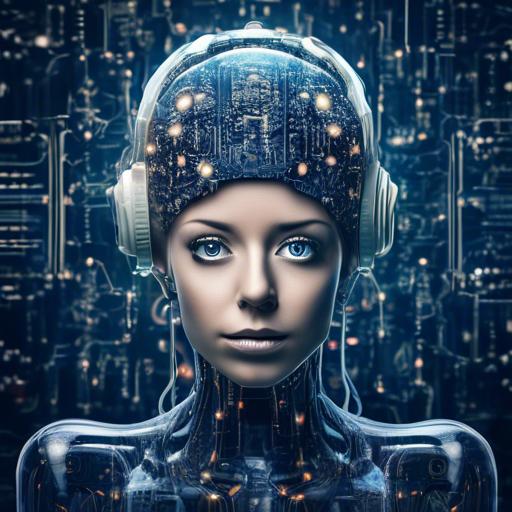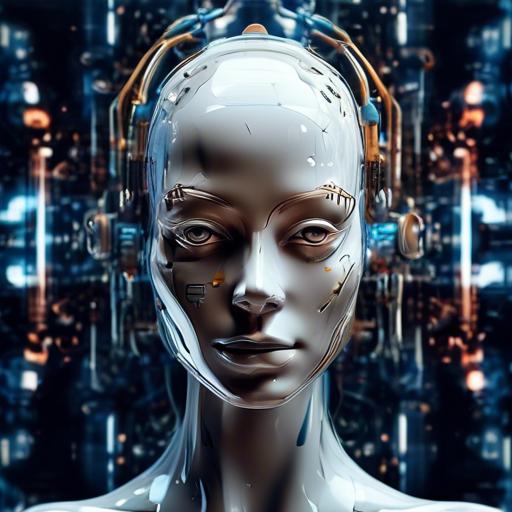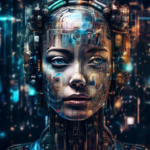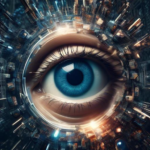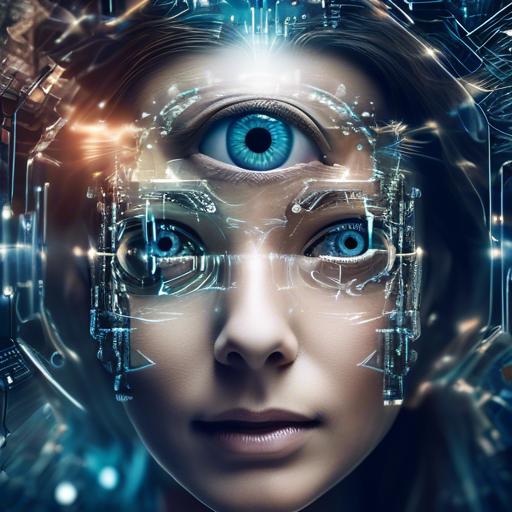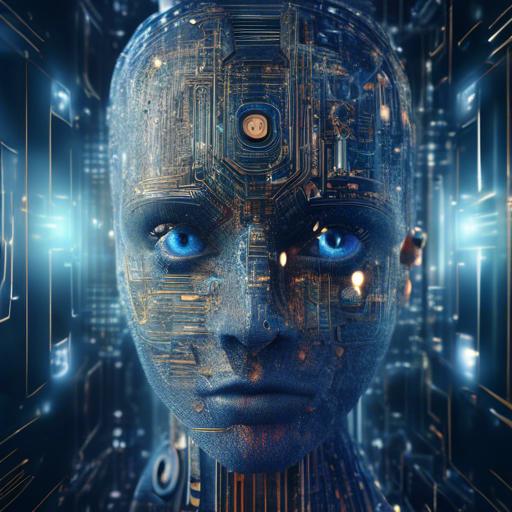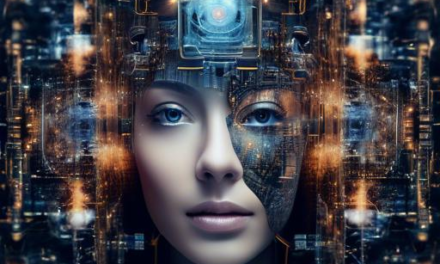Picture this: a world where breathtaking landscapes, whimsical creatures, and even your wildest dreams come to life with just the click of a button. Welcome to the realm of artificial intelligence, where machines are trained to conjure up captivating visuals from the depths of their artificial imaginations. In the age of digital artistry, AI has emerged as a master painter, capable of generating images that rival the creativity of human minds. But how does this fascinating technology actually learn to create such vivid and intricate visuals? In this supportive guide, we’ll embark on a journey through the artistic corridors of machine learning, unlocking the secrets behind AI’s ability to weave pixels into masterpieces. So, grab your virtual paintbrush, and let’s dive into the mesmerizing world of AI-driven image generation, where science meets art in the most enchanting way.
Table of Contents
- Understanding the Foundation: Basics of Image Generation AI
- Decoding Neural Networks: The Brain Behind the Art
- Training Algorithms: Sculpting Raw Data into Masterpieces
- Diving into Datasets: The Fuel for Creative AI
- From Pixels to Pictures: The Process of Image Synthesis
- Tackling Challenges: Ensuring Diversity and Realism in Outputs
- Ethical Considerations: Balancing Innovation with Responsibility
- Practical Tips: How to Get Started with AI Image Generation
- Future Horizons: What’s Next for AI in Visual Creativity
- To Wrap It Up
Understanding the Foundation: Basics of Image Generation AI
At the heart of image generation AI lies an intricate dance of algorithms, data, and neural networks. This synergy allows machines to create visual art, design patterns, and photorealistic images that can sometimes be indistinguishable from those made by human hands. Let’s explore the foundational elements that bring these generative capabilities to life.
Neural Networks and Layers:
- Neurons: The basic unit of a neural network, inspired by biological processes.
- Layers: Neurons are organized into layers – input, hidden, and output layers. Each layer’s neurons process data and pass it to the next.
- Activation Functions: Define how the inputs are transformed to the outputs on each neuron.
One of the primary architectures used in image generation is the **Generative Adversarial Network (GAN)**. The beauty of GANs is their two-part structure: a generator that creates images, and a discriminator that evaluates them. The generator aims to produce images that can fool the discriminator, while the discriminator strives to detect fake images. This adversarial relationship hones the system’s ability to generate ever more convincing images.
| Component | Function |
|---|---|
| Generator | Creates new images from random noise. |
| Discriminator | Distinguishes between real and generated images. |
**Autoencoders** also play a significant role in image generation. These neural networks are designed to compress image data into a latent (hidden) space and then reconstruct it back to the original image. By manipulating the latent space, autoencoders can generate new, creative images that adhere to the learned patterns and styles.
the combination of deep learning structures such as GANs and autoencoders, along with massive datasets, forms the cornerstone of modern image generation AI. As these technologies evolve, their potential to craft unique and compelling visuals only becomes more profound.
Decoding Neural Networks: The Brain Behind the Art
Neural networks, inspired by the human brain’s architecture, form the essence of how AI learns to generate stunning works of art. These intricate systems consist of layers of artificial neurons, each layer adding depth and complexity to the images produced. At the heart of this process is the convolutional neural network (CNN), a specialized kind of network designed to analyze visual data.
For the AI to create images, it must first be trained on a vast dataset of pictures. This dataset serves as the learning ground where the AI develops an understanding of shapes, colors, and patterns. During this phase, the AI undergoes numerous cycles of trial and error, gradually refining its ability to replicate and create unique images. Here are some key components involved in this learning process:
- Convolutional Layers: Detects features such as edges, textures, and simple shapes.
- Pooling Layers: Reduces the dimensionality, making the detection process more efficient.
- Fully Connected Layers: Integrates all features to form a coherent image.
How does it work? Imagine teaching a child to draw. Initially, the child’s drawings may be rudimentary, but as they receive feedback and practice, the drawings become more sophisticated. Similarly, the neural network adjusts its weights and biases through a process called backpropagation. Essentially, the network learns to minimize its mistakes by tweaking connections between neurons, honing its craft with each iteration.
One fascinating aspect of AI learning is the **generative adversarial network** (GAN) approach. This involves two neural networks: the generator and the discriminator. The generator creates images, while the discriminator evaluates them. The interplay between these two networks resembles a competitive game, pushing the generator to produce increasingly realistic images over time.
| Network Component | Function |
|---|---|
| CNN | Analyzes visual data |
| GAN | Generates and evaluates images |
| Backpropagation | Refines neural connections |
As technology advances, AI’s ability to generate images becomes more sophisticated, opening up new horizons in digital art, design, and even virtual reality. With each pixel it perfects, the neural network inches closer to replicating the intricacies of the human imagination, making the art truly an intersection of creativity and technology.
Training Algorithms: Sculpting Raw Data into Masterpieces
When it comes to transforming raw data into stunning visuals, artificial intelligence relies on the sophistication of training algorithms. These algorithms are the sculptors, shaping nondescript data into recognizable forms—like chiseling a block of marble into a detailed statue.
**Training algorithms** work by processing vast amounts of input data, learning from the patterns, shapes, colors, and structures they encounter. This learning process often involves:
- **Data Preprocessing**: Cleansing and normalizing the data to ensure consistency.
- **Feature Extraction**: Identifying crucial elements that need to be accounted for in the final image.
- **Model Training**: Adjusting parameters and nudging weights to align with desired outcomes.
- **Validation**: Testing the model on unseen data to verify its accuracy and adaptability.
One of the most popular methods to create these masterpieces is using **Generative Adversarial Networks (GANs)**. In GANs, two neural networks—the generator and the discriminator—engage in a game of cat and mouse. The generator creates images from random noise, while the discriminator evaluates them, distinguishing between real and fake inputs.
| Component | Role |
|---|---|
| Generator | Creates new, synthetic data samples. |
| Discriminator | Distinguishes between real and synthetic samples. |
As the two networks contend, their mutual learning accelerates. The generator’s creations become increasingly realistic, while the discriminator’s judgment sharpens. This adversarial process continues until the generated images are almost indistinguishable from the real ones.
Yet, achieving such prowess isn’t just about the algorithm alone. The **quality of data** fed into these systems profoundly influences the final product. Diverse and representative datasets enable AI to grasp a wide array of styles and nuances, much like a seasoned artist drawing from varied experiences.
Diving into Datasets: The Fuel for Creative AI
At the core of **AI’s remarkable ability to generate images** lies an extensive repository of datasets. These datasets aren’t just piles of random pictures; they are meticulously curated collections that fuel the AI’s creative prowess. From landscapes to portraits, datasets bring a diverse range of visual elements to the AI’s virtual canvas.
To unleash the full potential of an AI, you need to understand the anatomy of these datasets. Picture this: a dataset brimming with thousands of images, each labeled with descriptive tags. This **annotated data** serves as a rich source of learning, allowing the AI to discern patterns, textures, and structures. Imagine how an artist examines hundreds of artworks to identify techniques and styles. Similarly, AI immerses itself in the dataset to learn the art of image generation.
| Dataset Component | Description |
|---|---|
| Images | High-quality, diverse visuals across various categories. |
| Labels | Keywords and descriptions for training comprehension. |
| Annotations | Detailed tags and notes augmenting dataset depth. |
**Curated datasets** are essential as they provide structure and a degree of predictability. AI models traverse these datasets, learning intricate details from the annotated data. Think of it as a musical apprentice studying sheet music: each note, rhythm, and tempo contributes to mastering the symphony. The precision and quality of annotations, therefore, determine how adeptly the AI will generate authentic and convincing images.
Here are some critical aspects to consider when dealing with datasets for creative AI:
* **Diversity:** Incorporate a wide range of subjects, styles, and scenes.
* **Quality:** Ensure high-resolution images to capture intricate details.
* **Balance:** Include equal representation of all categories to avoid bias.
In essence, datasets are not just collections; they are **learning palettes** for AI to blend colors, shapes, and narratives into masterpieces. By investing time in developing a strong, diverse, and well-annotated dataset, you set the foundation for an AI that can generate stunning, original images with unparalleled creativity.
From Pixels to Pictures: The Process of Image Synthesis
Imagine the magic of a blank canvas gradually morphing into a vibrant, lifelike picture. This enchantment is powered by neural networks, especially **Generative Adversarial Networks** (GANs). The artistry behind GANs involves two main components: the Generator and the Discriminator.
- The **Generator** creates images from random noise.
- The **Discriminator** evaluates the authenticity of these images against real samples.
Here, the **Generator** and **Discriminator** play a fascinating game of cat-and-mouse. The generator tries to fool the discriminator, while the discriminator strives to distinguish between real and synthetic images. This iterative learning process results in the generation of incredibly realistic images over time.
| Component | Function |
|---|---|
| Generator | Creates images from noise |
| Discriminator | Evaluates the authenticity of images |
Training GANs involves several key steps:
- **Initialization:** Models are initialized with random weights.
- **Training Loop:** The generator and discriminator are trained alternatively.
- **Evaluation:** Metrics such as Inception Score and Fréchet Inception Distance assess image quality.
Each iteration in the training loop improves the Generator’s capability to produce more accurate imagery while honing the Discriminator’s skill in detecting fakes. The loop perpetuates until the generated images are nearly indistinguishable from real ones, rendering the discriminator almost ineffectual.
Through this enlightening process, neural networks learn not just to mimic reality but also to broaden the horizons of creative possibility, turning **pixels into pictures**.
Tackling Challenges: Ensuring Diversity and Realism in Outputs
Creating realistic and diverse images through AI is no small feat. One of the primary hurdles is ensuring inclusivity in the data sets used for training. **Diverse data sets** help AI learn the vast range of human experiences and environments. Neglecting this aspect can lead to biased or unrealistic outputs that fail to represent the true variety of the world. Ensuring diversity involves meticulously curating images from different demographics, cultures, and settings.
Moreover, the pursuit of realism in AI-generated images is an ongoing challenge. Realism is achieved when AI understands the subtleties of the real world, from the texture of a fabric to the intricacies of human expression. This involves **layering multiple complex models** and refining algorithms to mimic fine details authentically. Techniques like enhancing image resolution and incorporating environmental context play a crucial role.
To tackle these challenges, collaboration between data scientists, ethicists, and domain experts is essential. They ensure the AI systems are trained on ethically sourced, well-rounded datasets and hold **continuous bias assessments** to improve fairness. Some strategies include:
- Aggregating data from global sources
- Employing synthetic data generation techniques
- Regularly updating training sets to reflect contemporary contexts
Another effective approach is using **feedback loops** where users can report biases or inaccuracies. This input gets fed back into the model, enhancing its learning process. Regular audits and public transparency reports also help maintain trust and accountability in AI image generation systems.
| Challenge | Strategy |
|---|---|
| Bias in Data | Diverse Data Aggregation |
| Lack of Realism | Layered Model Refinement |
| User Trust | Transparency Reports |
Ethical Considerations: Balancing Innovation with Responsibility
As we delve deeper into the realm of AI-generated images, it becomes paramount to address the ethical considerations accompanying this innovation. Striking a balance between creativity and responsibility is essential; neglecting ethical guidelines can lead to misuse and unintended consequences.
**Transparency** plays a crucial role in ensuring AI’s responsible use. Developers and organizations should openly disclose how their AI models are trained, what data sets are used, and the potential limitations. Letting users and stakeholders be aware fosters trust and informed decision-making. Some key points to consider are:
- Data Privacy: Ensuring user data is anonymized and secured.
- Inclusivity: Using diverse data sets to avoid biases.
- Accountability: Having clear policies in place to address misuse.
Another ethical concern is the **misrepresentation** of AI-generated images. While these images can enhance creativity and innovation, they may also be manipulated to spread misinformation. Hence, it’s crucial to implement mechanisms for verifying the authenticity of images. Educating users on recognizing AI-generated content can act as a safeguard against deception.
| Ethical Concern | Solution |
|---|---|
| Data Privacy | Implement strong encryption and anonymization protocols. |
| Misinformation | Develop detection tools and educate users about AI-generated content. |
| Bias | Use diverse data sets and continuously monitor outputs. |
Ultimately, fostering a collaborative approach between developers, ethicists, and the general public can lead to mutually beneficial solutions. Incorporating **ethical guidelines** during the development phase not only prevents negative outcomes but also enhances the credibility and acceptance of AI technologies.
By championing transparency, addressing potential misuse, and promoting education, we can ensure that generating images via AI contributes positively to society while respecting ethical boundaries.
Practical Tips: How to Get Started with AI Image Generation
Transforming concepts into visual masterpieces with AI doesn’t have to be intimidating. To aid those eager to dive into AI image generation, here’s a quick guide to get you started on this exciting journey.
1. Familiarize Yourself with the Basics:
Before you dive into generating images with AI, it’s essential to understand the fundamental concepts. Consider exploring resources on neural networks, deep learning, and generative adversarial networks (GANs). These topics form the backbone of how AI learns to create imagery from scratch. There are numerous online courses and tutorials that can help demystify these concepts.
2. Choose Your Tools Wisely:
There are many platforms and software to help you generate images with AI. Here are a few to consider:
- DALL-E: Developed by OpenAI, this tool can generate incredibly detailed images from textual descriptions.
- Artbreeder: A collaborative platform where you can blend images to create new versions using AI.
- Deep Dream: Created by Google, it’s a program that uses neural networks to enhance and create visuals.
3. Start Small with Pre-Trained Models:
For beginners, using pretrained models can be a great starting point. These models have been trained on extensive datasets and can produce impressive results. Experimenting with these can provide insight into how different parameters affect the output. Often, platforms like TensorFlow and PyTorch offer pretrained models that you can tweak.
4. Fine-Tuning and Customization:
Once you’re comfortable with the basics, you might want to adapt a model to your specific needs, a process known as fine-tuning. This involves taking an existing model and retraining it on a new dataset of your choice. It requires more computational power and understanding but yields personalized results.
5. Practice Ethical AI Usage:
AI image generation holds tremendous potential, but it’s essential to approach it responsibly. Always consider the ethical implications of your work. Avoid generating misleading content or images that could be harmful. Many AI communities discuss the ethics of tech, and joining these talks can provide you with valuable insight.
| Tool | Type | Unique Feature |
|---|---|---|
| DALL-E | Image Generator | Text to Image |
| Artbreeder | Collaborative Platform | Blending Images |
| Deep Dream | Neural Network | Image Enhancement |
Embarking on the AI image generation journey can be profoundly rewarding. With these practical tips, you are well on your way to creating stunning AI-generated visuals. Happy creating!
Future Horizons: What’s Next for AI in Visual Creativity
AI is not just about understanding and interpreting existing visuals; its real magic lies in generating entirely new images from scratch. The future of AI in visual creativity looks promising with several pioneering advancements emerging on the horizon.
- **Neural Style Transfer** – an innovative technique that allows AI to combine the content of one image with the artistic style of another.
- **Generative Adversarial Networks (GANs)** – these systems pit two neural networks against each other to produce incredibly realistic images.
- **Creative Adjacency** – AI is increasingly capable of producing new and unique images based on a combination of predefined parameters and spontaneous creativity.
Let’s take a closer look at some of the cutting-edge methods propelling AI’s creative capacities forward:
| Method | Description | Real-World Application |
|---|---|---|
| **DeepDream** | An algorithm that enhances and exaggerates patterns in images | Used in generating psychedelic and surreal images |
| **VQ-VAE-2** | A two-stage generative model that can create high-fidelity images | Generates improved high-resolution images for art and design |
| **CLIP by OpenAI** | Connects images and text to generate descriptive visual content | Useful for creating illustrations based on textual descriptions |
The fascinating interplay between creativity and precision in Generative Adversarial Networks (GANs) has already started to mimic human creativity. By continuously refining their outputs, these networks have learned to produce stunningly lifelike and imaginative visuals, pushing boundaries and setting new standards for digital art. With a balance of machine-learning prowess and artistic flair, AI is set to evolve the landscape of visual creativity.
To Wrap It Up
As we delve deeper into the fascinating world of AI-generated images, it is clear that the creative possibilities are endless. Through advanced algorithms and deep learning techniques, AI is continuously evolving and improving its ability to generate stunning and lifelike visuals. While there may be challenges along the way, the potential for AI to revolutionize the field of image generation is truly exciting. So let’s continue to support and explore the capabilities of AI as it learns and grows, pushing boundaries and unlocking new realms of creativity. The future of AI-generated images is bright, and we can’t wait to see what incredible masterpieces it will create next. The possibilities are truly limitless!

